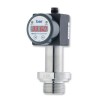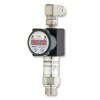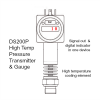Pressure gauges for measuring high temperature fluids or gases. These high temperature pressure gauges are have or include optional extra design features to protect the pressure gauge from high temperature media.
Sensitive components such as digital displays, micro-electronics and sensor elements are easily damaged by high temperatures and therefore it is necessary to introduce a method of thermal isolation between the vulnerable parts of the pressure gauge.
A temperature barrier can be accomplished by adding a cooling element between the process connection and the pressure gauge which dissipates the heat into the ambient temperature environment before it reaches the pressure gauge.
Products
 DS200P Sanitary Low Range Pressure Gauge, Switch and Sensor - All in one electronic switch, gauge and sensor designed specifically for use in the food, drink and biomedical industry for measuring process pressures.
DS200P Sanitary Low Range Pressure Gauge, Switch and Sensor - All in one electronic switch, gauge and sensor designed specifically for use in the food, drink and biomedical industry for measuring process pressures. DS201P High Range Flush Pressure Gauge, Switch and Sensor - High pressure sensor, electronic switch and digital gauge with an all welded stainless steel flush diaphragm for high viscosity liquids.
DS201P High Range Flush Pressure Gauge, Switch and Sensor - High pressure sensor, electronic switch and digital gauge with an all welded stainless steel flush diaphragm for high viscosity liquids.
Applications
 250psig hi-temp hydraulic oil digital pressure gauge and 4-20mA output - Digital pressure gauge with 4 to 20 mA output for pipe mounted use in synthetic hydraulic oil measurement applications, capable of measuring 0 to 250 psi g pressure with 1% accuracy and connected using a G1/2 male fitting.
250psig hi-temp hydraulic oil digital pressure gauge and 4-20mA output - Digital pressure gauge with 4 to 20 mA output for pipe mounted use in synthetic hydraulic oil measurement applications, capable of measuring 0 to 250 psi g pressure with 1% accuracy and connected using a G1/2 male fitting. 16 bar, 200°C steam pressure transmitter and gauge - Combined pressure transmitter and indicator in one package with the option for use with high temperature media such as steam at 200°C
16 bar, 200°C steam pressure transmitter and gauge - Combined pressure transmitter and indicator in one package with the option for use with high temperature media such as steam at 200°C Autoclave pressure sensor and display with 10 bar range - We are looking for a autoclave pressure sensor and display for connecting to a laboratory steam sterilising autoclave and operates at about 10 bar @160°C
Autoclave pressure sensor and display with 10 bar range - We are looking for a autoclave pressure sensor and display for connecting to a laboratory steam sterilising autoclave and operates at about 10 bar @160°C 10 bar g steam pressure transmitter and indicator - Steam pressure transmitter with LED display indicator for measuring 0 to 10 bars with in-built temperature reducer
10 bar g steam pressure transmitter and indicator - Steam pressure transmitter with LED display indicator for measuring 0 to 10 bars with in-built temperature reducer
